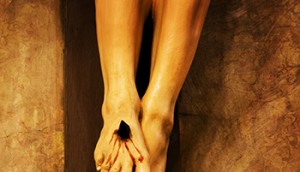Wounds of Christ
The passion and death of Jesus appears in the four gospels and each dwells on certain details of that great story. John’s Gospel, more than the others, finds Jesus’ wounds particularly significant; they’re unlikely signs revealing the mystery of the Word made flesh.
From Jesus’ trial before Pilate — who questions him extensively about his kingdom – John’s Gospel turns to Calvary where he is crucified. A small symbolic group stand beneath the cross of “the King of the Jews”– Mary, the mother of Jesus, the disciple whom he loved, and a few others. A gentile soldier joins them.This group represent the “new Jerusalem,” spoken of by the Prophet Zechariah: God “will pour out a spirit of compassion and supplication on the house of David and the inhabitants of Jerusalem so that when they look on the one whom they have pierced, they shall mourn for him, as one mourns for an only child, and weep bitterly over him, as one weeps over a firstborn.” (Zechariah 11, 10; cf. John 19, 37)
As they mourn over him they receive a precious gift. “It is finished!” Jesus declares, and bowing his head, he pours out his spirit on them. A Roman soldier thrusts a spear into Jesus’ side to ensure his death. “Immediately blood and water flowed out.” (John 19, 34)Blood, a sign of his life, flows on those standing beneath his cross. Water, signifying the Spirit within him, is poured out on the world represented in them.
Far from ending his life, death is the moment Jesus shares his life.
“This is the one who came by water and blood, Jesus Christ.” (I John 5,6)Only later, though, did his followers see the significance in his final moments.
Earlier in John’s Gospel, Jesus spoke of water and blood as symbols of his mission. He invited the thirsty to come to him and drink, and “from within him rivers of living water shall flow.” (John 7, 37-38) Now on Calvary, his promise is fulfilled, as the Prophet Zechariah had written: “On that day a fountain shall be opened for the house of David and the inhabitants of Jerusalem, to cleanse them from sin and impurity.” (Zechariah 13, 1)
Earlier, in the synagogue at Capernaum, Jesus called his blood “true drink.” “Truly, I say to you, unless you eat the flesh of the Son of man and drink his blood, you have no life in you. Those who eat my flesh and drink my blood have eternal life, and I will raise them up on the last day… Those who eat my flesh and drink my blood abide in me, and I in them.” (John 6,53-56)
On Calvary, water and blood from the wounds of Jesus point to the saving mystery of his death. A few days later, the Risen Jesus came his disciples locked in the upper room; “… he showed them his hands and his side. At the sight of the Lord, the disciples rejoiced.” His wounds proclaim his triumph over death, and the disciples are overjoyed seeing them. (John 20,20)
His Wounds Bring Belief
The next week, Jesus appears again and invites Thomas — the disciple who was absent at his first appearance and doubted his resurrection — to put his finger into the nail marks in his hands and to put his hand into his side, and believe. His wounds bring belief to the wavering disciple: “My Lord and my God.”(John 20,28)
St. John Chrysostom (+407) in a baptismal homily notes that, when the soldier pierced his side, Jesus was on the cross. From his wounds the sacraments of Baptism and the Eucharist are given to his church. Water comes forth and then the blood, Chrysostom says, “because first comes baptism and then the mysteries (the Eucharist).” With his spear, the soldier pierced the temple wall, the saint goes on, “but I find the treasure and get the wealth.” (cf. John 2,19)
Like Adam, who was cast into a deep sleep to form Eve, Christ brings forth the church from his side through sacramental signs. “From his side Christ formed the church just as he formed Eve from the side of Adam.” (Baptismal Homilies, 3,16-18) Many early commentators offer this similar interpretation.
St. Cyril of Jerusalem (+387) in another baptismal homily preached in Jerusalem in the church of the Holy Sepulcher says: “… you descended three times into the water and ascended, showing the symbol of the three days of Christ’s burial… How kind and loving! Christ received nails in his hands and feet, while I without pain and trials are given freely a gift of salvation because I share in his suffering.”
The wounds of Christ so prominently portrayed in John’s Gospel have an important place in the catechesis, preaching and spirituality of the Christian church. His gifts are given to all, because all are redeemed by his death and called to live in his Spirit.
Artists often approached these sacred signs with a cosmic vision. They saw the grave of Adam beneath the cross — symbolically representing the generations waiting for redemption. Creation, symbolized by the sun and the moon, look on in expectation. In John’s Gospel Calvary is a place of cosmic redemption. Sometimes, angels collect the blood from Jesus’ wounds in cups that indicate the mystery of the Eucharist.
In this vision of things, one day represents all days. On Calvary, the Day of the Lord is revealed, as the prophets promised.

